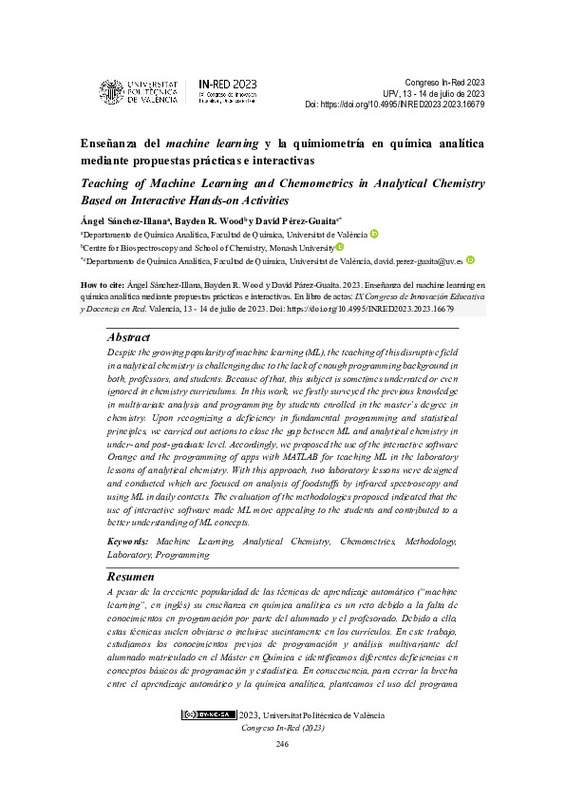JavaScript is disabled for your browser. Some features of this site may not work without it.
Buscar en RiuNet
Listar
Mi cuenta
Estadísticas
Ayuda RiuNet
Admin. UPV
Enseñanza del machine learning y la quimiometría en química analítica mediante propuestas prácticas e interactivas
Mostrar el registro sencillo del ítem
Ficheros en el ítem
| dc.contributor.author | Sánchez Illana, Ángel
|
es_ES |
| dc.contributor.author | Wood, Bayden
|
es_ES |
| dc.contributor.author | Pérez Guaita, David
|
es_ES |
| dc.date.accessioned | 2023-12-07T10:35:06Z | |
| dc.date.available | 2023-12-07T10:35:06Z | |
| dc.date.issued | 2023-10-06 | |
| dc.identifier.isbn | 9788413960883 | |
| dc.identifier.uri | http://hdl.handle.net/10251/200550 | |
| dc.description.abstract | [EN] Despite the growing popularity of machine learning (ML), the teaching of this disruptive field in analytical chemistry is challenging due to the lack of enough programming background in both, professors, and students. Because of that, this subject is sometimes underrated or even ignored in chemistry curriculums. In this work, we firstly surveyed the previous knowledge in multivariate analysis and programming by students enrolled in the master’s degree in chemistry. Upon recognizing a deficiency in fundamental programming and statistical principles, we carried out actions to close the gap between ML and analytical chemistry in under- and post-graduate level. Accordingly, we proposed the use of the interactive software Orange and the programming of apps with MATLAB for teaching ML in the laboratory lessons of analytical chemistry. With this approach, two laboratory lessons were designed and conducted which are focused on analysis of foodstuffs by infrared spectroscopy and using ML in daily contexts. The evaluation of the methodologies proposed indicated that the use of interactive software made ML more appealing to the students and contributed to a better understanding of ML concepts. | es_ES |
| dc.description.abstract | [ES] A pesar de la creciente popularidad de las técnicas de aprendizaje automático (“machine learning”, en inglés) su enseñanza en química analítica es un reto debido a la falta de conocimientos en programación por parte del alumnado y el profesorado. Debido a ello, estas técnicas suelen obviarse o incluirse sucintamente en los currículos. En este trabajo, estudiamos los conocimientos previos de programación y análisis multivariante del alumnado matriculado en el Máster en Química e identificamos diferentes deficiencias en conceptos básicos de programación y estadística. En consecuencia, para cerrar la brecha entre el aprendizaje automático y la química analítica, planteamos el uso del programa interactivo Orange y la programación de aplicaciones con MATLAB. Utilizando este enfoque, diseñamos y llevamos a cabo dos sesiones prácticas consistentes en el análisis de alimentos mediante espectroscopía infrarroja y en la implementación de modelos de aprendizaje automático aplicados a contextos cotidianos. Tras evaluar las metodologías propuestas, comprobamos que estas hacen el aprendizaje automático más atractivo para el estudiantado contribuyendo a su mejor aprendizaje. | es_ES |
| dc.description.sponsorship | Ayuda Margarita Salas (ref. UP2021-044-MS21-084) del Ministerio de Universidades-Next Generation EU; Ayuda RyC (ref. RYC2019-026556-I) Ministerio de Investigación y Ciencia (MCIN/AEI/10.13039/501100011033). | es_ES |
| dc.format.extent | 15 | es_ES |
| dc.language | Español | es_ES |
| dc.publisher | Editorial Universitat Politècnica de València | es_ES |
| dc.relation.ispartof | In-Red 2023 - IX Congreso Nacional de Innovación Educativa y Docencia en Red | |
| dc.rights | Reconocimiento - No comercial - Compartir igual (by-nc-sa) | es_ES |
| dc.subject | Aprendizaje Automático | es_ES |
| dc.subject | Machine Learning | es_ES |
| dc.subject | Química Analítica | es_ES |
| dc.subject | Quimiometría | es_ES |
| dc.subject | Metodología | es_ES |
| dc.subject | Laboratorio | es_ES |
| dc.subject | Analytical Chemistry | es_ES |
| dc.subject | Chemometrics | es_ES |
| dc.subject | Methodology | es_ES |
| dc.subject | Laboratory | es_ES |
| dc.subject | Programming | es_ES |
| dc.title | Enseñanza del machine learning y la quimiometría en química analítica mediante propuestas prácticas e interactivas | es_ES |
| dc.title.alternative | Teaching of Machine Learning and Chemometrics in Analytical Chemistry Based on Interactive Hands-on Activities | es_ES |
| dc.type | Capítulo de libro | es_ES |
| dc.type | Comunicación en congreso | es_ES |
| dc.identifier.doi | 10.4995/INRED2023.2023.16679 | |
| dc.relation.projectID | info:eu-repo/grantAgreement/MIU//UP2021-044-MS21-084 | es_ES |
| dc.relation.projectID | info:eu-repo/grantAgreement/MICINN//RYC2019-026556-I | es_ES |
| dc.rights.accessRights | Abierto | es_ES |
| dc.description.bibliographicCitation | Sánchez Illana, Á.; Wood, B.; Pérez Guaita, D. (2023). Enseñanza del machine learning y la quimiometría en química analítica mediante propuestas prácticas e interactivas. Editorial Universitat Politècnica de València. 246-260. https://doi.org/10.4995/INRED2023.2023.16679 | es_ES |
| dc.description.accrualMethod | OCS | es_ES |
| dc.relation.conferencename | IN-RED 2023: IX Congreso de Innovación Educativa y Docencia en Red | es_ES |
| dc.relation.conferencedate | Julio 13-14, 2023 | es_ES |
| dc.relation.conferenceplace | Valencia, España | es_ES |
| dc.relation.publisherversion | http://ocs.editorial.upv.es/index.php/INRED/INRED2023/paper/view/16679 | es_ES |
| dc.description.upvformatpinicio | 246 | es_ES |
| dc.description.upvformatpfin | 260 | es_ES |
| dc.type.version | info:eu-repo/semantics/publishedVersion | es_ES |
| dc.relation.pasarela | OCS\16679 | es_ES |
| dc.contributor.funder | Ministerio de Universidades | es_ES |
| dc.contributor.funder | Ministerio de Ciencia e Innovación | es_ES |








